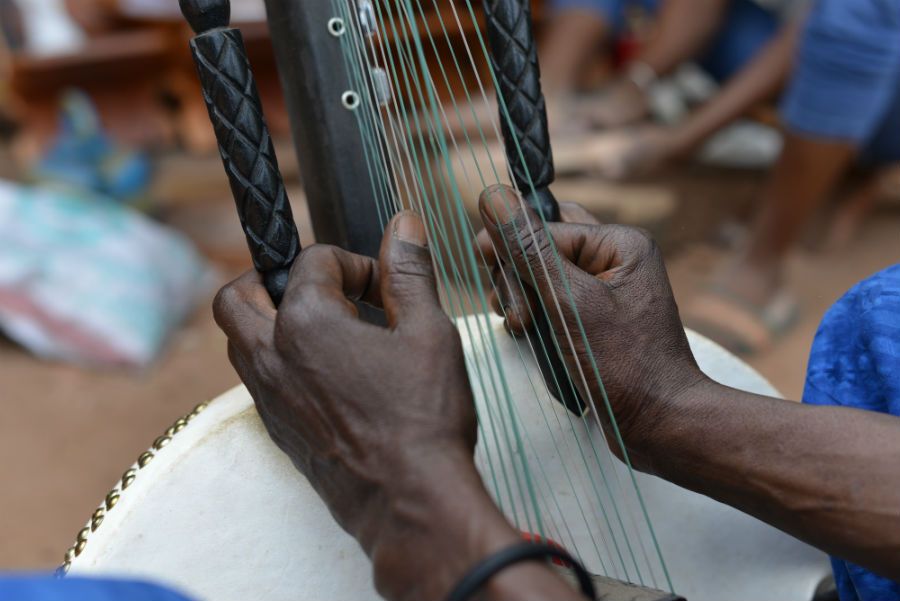Some things you just have to be born into. Sona Jobarteh was born in 1983 into one of the five principal Kora-playing Griot families from West Africa – she is the first female professional Kora player to come from a Griot family (a Griot is a West African historian, storyteller, praise singer, poet, or musician and generally a repository of the culture). She is the granddaughter of the Master Griot of his generation, Amadu Bansang Jobarteh, cousin of the well-known, celebrated Kora player Toumani Diabate as well as the sister of the renowned Diaspora Kora player Tunde Jegede – Wikipedia. Yes, she was born into the tradition but grew up in Britain and has studied the Kora from the age of three. She attended the Royal College of Music, where she studied cello, piano and harpsichord, and soon after went on to the Purcell School of Music to study composition. She also completed a degree at SOAS, University of London. She is fluent in Manding, and, above all she is a master Kora player. She gave her first performance at London’s Jazz Cafe when she was four years old, and has performed at festivals several times in her early childhood before going on to an extensive professional adult career.
And one may ask, what is a Kora?
“A Kora is a Mandinka harp built from a small Calabash cut in half and covered with cow skin to make a resonator with a long hardwood neck. The skin is supported by two handles that run under it. It has 21 strings, each playing a different note. It supports a  notched double free-standing bridge. It doesn’t fit into any one category of musical instruments, but rather several, and must be classified as a “double-bridge-harp-lute”. The strings run in two divided ranks, making it a double harp. They do not end in a soundboard but are held in notches on a bridge, making it a bridge harp. They originate from a string arm or neck and cross a bridge directly supported by a resonating chamber, making it a lute too. The sound of a kora resembles that of a harp. The thumbs are used to pluck the strings while the remaining fingers hold the hand posts and secure the instrument.. The music utilizes polyrhythmic patterns in Ostinato Riffs (“Kumbengo”) and improvised solo runs (“Birimintingo”) that are played at the same time by skilled players.” – Wikipedia
notched double free-standing bridge. It doesn’t fit into any one category of musical instruments, but rather several, and must be classified as a “double-bridge-harp-lute”. The strings run in two divided ranks, making it a double harp. They do not end in a soundboard but are held in notches on a bridge, making it a bridge harp. They originate from a string arm or neck and cross a bridge directly supported by a resonating chamber, making it a lute too. The sound of a kora resembles that of a harp. The thumbs are used to pluck the strings while the remaining fingers hold the hand posts and secure the instrument.. The music utilizes polyrhythmic patterns in Ostinato Riffs (“Kumbengo”) and improvised solo runs (“Birimintingo”) that are played at the same time by skilled players.” – Wikipedia

Traditional Koras feature 21 strings, eleven played by the left hand and ten by the right. Modern Koras made in the Casamance region of southern Senegal sometimes feature additional bass strings, adding up to four strings to the traditional 21. Strings were traditionally made from thin strips of hide, for example antelope skin – now most strings are made from harp strings or nylon fishing line, sometimes plaited together to create thicker strings. A vital accessory in the past was the nyenmyemo, a leaf-shaped plate of tin or brass with wire loops threaded around the edge. Clamped to the bridge, it produced sympathetic sounds, serving as an amplifier since the sound carried well in the open air. In today’s environment players usually prefer or need an electric pickup. By moving leather tuning rings up and down the neck, a Kora player can retune the instrument into one of four seven-note scales. These scales are close in tuning to western major, minor and Lydian modes.
Below are two short videos with Sona playing a traditional Kora with leather tuning straps followed by one where she uses the more modern version utilizing Guitar tuning gears.
https://www.youtube.com/watch?v=bxk-IVvma8g
This following video is from a longer concert…….
@@@@@@@@@@@@@

